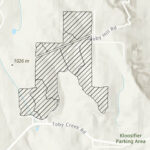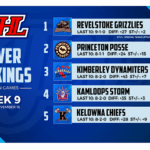Home »

It’s an active month for night sky events
October is an active month for night sky events. It holds a Lunar Eclipse, a Partial Solar Eclipse and three small meteor showers.
College of the Rockies is also offering two new evening Astronomy Sessions this October.
ECLIPSES
Total Lunar Eclipse: occurred Wednesday, Oct 8. This is the second of four lunar eclipses happening this year.
For you early morning people, it occurred Wednesday morning, at 4:55 a.m. Peeking through clouds, it turned a dim red/orange colour then. The Moon entered the outer part of the Earth’s shadow (penumbra) at 2:17 a.m. The Moon passed through the inner part of the shadow (the umbra) from 4:27 to 5:22 a.m., for about an hour. (The umbra is 1.5 degrees wide, and the Moon is 0.5 degrees wide). The Moon will be in the centre of the shadow at 4:55 a.m. Finally the Moon exits the penumbra at 7:32 a.m.
The following is a sequence of photos taken from Cranbrook from 6 a.m. every six minutes, as the Moon slowly climbed out of the Earth’s umbra shadow.
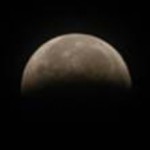
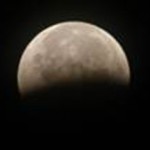
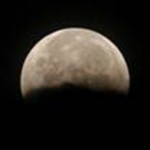
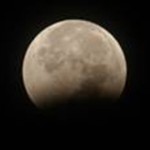
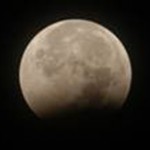
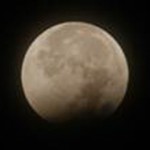
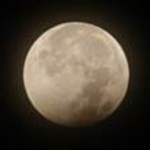 The hazy glow around the edge was due to thin cloud. I shot this through a 102mm diameter refractor telescope. Note the Moon is turned sideways as it sets in the west. There was about 90% cloud cover previously.
The hazy glow around the edge was due to thin cloud. I shot this through a 102mm diameter refractor telescope. Note the Moon is turned sideways as it sets in the west. There was about 90% cloud cover previously.
The Partial Solar Eclipse happens on Thursday afternoon, Oct. 23 at 4:06 p.m. It should start around 2:43 p.m. and end at 5:23 p.m. The centre of the Moon’s penumbral shadow will pass north of us and arc down over Hudson‘s Bay and the Great Lakes. It should last for two hours, 40 min. It’s a partial; nobody sees the total eclipse of the Sun this time.
METEOR SHOWERS
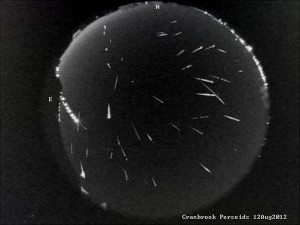 Spring is a slow time for meteors, but starting with the Perseids in August and continuing into the fall and winter the sky goes active with meteors.
Spring is a slow time for meteors, but starting with the Perseids in August and continuing into the fall and winter the sky goes active with meteors.
This photo shows all the Perseid meteors from the night of August 12, 2012. It was taken with our college meteor video camera, using a fisheye lens to show the entire sky at once. Notice all the meteor tails point back to a single point (the radiant)—those are Perseids. There’s a few that don’t, those would be “sporatic” meteors.
The Draconid Meteor Shower
On Oct 8-9: (peaking at 8 a.m. Oct. 8 to 1 a.m. Oct 9) possible 30 meteors/hour. The Draconid meteor shower, is one of the two larger meteor showers to annually flash across the skies in October. The Draconids appear to shoot from the northern constellation Draco the Dragon: these are dust and ice particles encountered when the Earth passes through the orbit of Comet 21 P/ Giacobini-Zinner. The best time to view the Draconids is just after the Sun sets and right before nightfall, when Draco is highest in the sky. Unfortunately the glow in the sky from the full moon makes it difficult to see the dimmer meteors.
The next appreciable showers are…
The Epsilon Geminid Meteor Shower – Saturday, Oct. 18, with speeds of 70 kps, but not as many, just three meteors/hr. (Not to be confused with the better Dec. 14 Geminid shower.)
The Orionid Meteor Shower – Tuesday, Oct. 21 follows. We should get about 25 meteors per hour entering the atmosphere at 66 kilometers per second. There will be good viewing conditions since we’ll have dark skies due to the new moon.
The Leonids happen on Nov. 17; a slower 15 meteors/hr, but fast trails at 71 km/s.
The Geminids are pretty nice which happen on Dec. 14. This is a more active shower, with 120 meteors/hour, which travel slower across the sky at 35 km/s.

Continuing Ed Astronomy Sessions
Note that the college has two astronomy evening sessions coming up, on Constellations, and another on Astrophotography.
The one on Thursday Oct 9/16 is on Stars and Constellations held from 7-10 p.m.; Can you find the pointer stars of the big dipper? Which constellation is shown here? We also talk about Roman legends that the constellations were named after (like the hero Perseus holding Medusa’s head (Algol), riding Pegasus, to save Andromeda chained to the rocks, from the sea monster Cetus). It touches on interesting features on the Moon and a bit on Meteors. We also do some colourful lab demos like making air glow in a bell jar with a vacuum pump and high voltage. We try to make it entertaining: can you name the top ten astronomy songs? You may be surprised to find that a lot of big rock bands have great astronomy songs.
Astrophotography
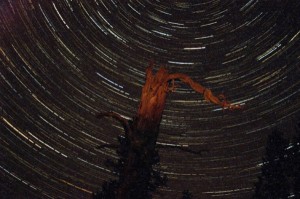 A session on Astrophotography is scheduled for Thursday, evenings Oct. 23 and 30, which teaches you how to use the college’s eight Nikon cameras on tripods to take star and meteor photos. You should be able to use similar techniques with your own cameras. The photo of the tree above was taken at night near Eager Hill, with the stars rotating behind it. I briefly flashed my light on the tree top to help show it.
A session on Astrophotography is scheduled for Thursday, evenings Oct. 23 and 30, which teaches you how to use the college’s eight Nikon cameras on tripods to take star and meteor photos. You should be able to use similar techniques with your own cameras. The photo of the tree above was taken at night near Eager Hill, with the stars rotating behind it. I briefly flashed my light on the tree top to help show it.
If you haven’t signed up yet, the courses cost $99 each, which gets you two three-hour sessions.
Rick Nowell,
Astronomy Lab Tech,
College of the Rockies


